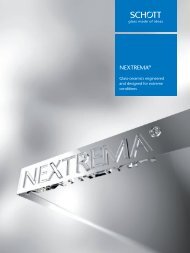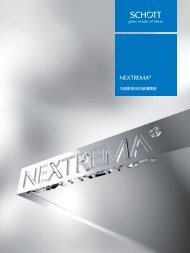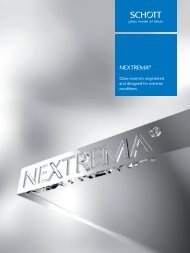Technology Magazine "SCHOTT solutions" Edition 2/2014
The SCHOTT solutions glass magazine features articles, reports and interviews on glass technological challenges from all over the world. The SCHOTT Technology Magazine. Beiträge, Reportagen und Interviews zu Lösungen von SCHOTT für technologische Herausforderungen weltweit.
The SCHOTT solutions glass magazine features articles, reports and interviews on glass technological challenges from all over the world.
The SCHOTT Technology Magazine. Beiträge, Reportagen und Interviews zu Lösungen von SCHOTT für technologische Herausforderungen weltweit.
You also want an ePaper? Increase the reach of your titles
YUMPU automatically turns print PDFs into web optimized ePapers that Google loves.
<strong>SCHOTT</strong> SOLUTIONS 2/14 ENERGY ENERGIE<br />
Photos Fotos : schott/ H.-R. Schulz<br />
MEETING THE<br />
HIGHEST STANDARDS<br />
HÖCHSTE ANSPRÜCHE ERFÜLLEN<br />
schott develops and manufactures<br />
glass-to-metal electrical penetrations<br />
that stand up to high temperatures<br />
as well as overpressure in nuclear<br />
reactors.<br />
schott entwickelt und produziert<br />
Glas-Metall-Durchführungen, die<br />
sowohl hohen Temperaturen als<br />
auch Überdruck in Kernreaktoren<br />
standhalten.<br />
Nuclear power provides around 11 percent of the world’s electricity, and there has been increased focus on the safety<br />
of this energy generation source since the Fukushima Daiichi nuclear accident in Japan in 2011. With its electrical<br />
penetration assemblies (epas), schott provides a signifi cant increase in nuclear safety.<br />
Kernenergie deckt 11 Prozent des weltweiten Energieverbrauchs. Die Sicherheit dieser Energieform steht seit dem<br />
nuklearen Unfall von Fukushima Daiichi 2011 in Japan im Mittelpunkt öffentlicher Diskussionen. Großdurchführungen<br />
von schott sorgen künftig für ein Plus an nuklearer Sicherheit.<br />
CORRINA THOMSON<br />
A<br />
fter researching the accident, Fukushima’s operators tepco<br />
found that the tsunami, which cut off all power to the plant’s<br />
cooling system, led to the temperature inside the reactor containment<br />
rising significantly. Normal operating temperature was about<br />
60 degrees Celsius and it rose to more than 250 degrees Celsius. The<br />
pressure was more than doubled. These extreme temperature and<br />
B<br />
ei der Untersuchung des Unfalls in Fukushima fand der<br />
Kernkraftwerksbetreiber tepco heraus, dass der Tsunami die<br />
Stromversorgung des Kühlsystems im Kraftwerk zum Erliegen<br />
brachte und dabei einen deutlichen Temperaturanstieg im Reaktorsicherheitsbehälter<br />
verursachte. Während die Betriebstemperatur<br />
im Normalbetrieb bei etwa 60 °C lag, stieg sie aufgrund der Über-<br />
42

















